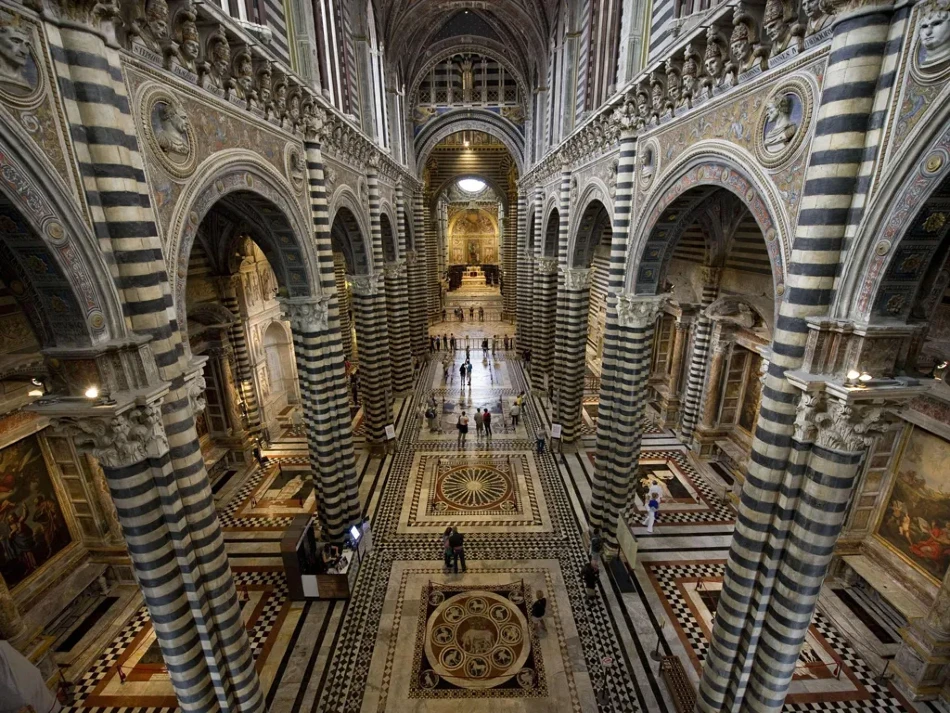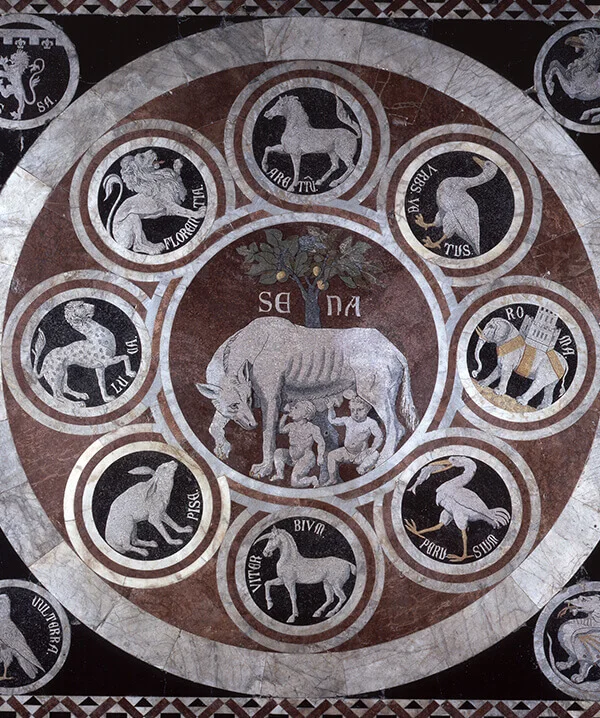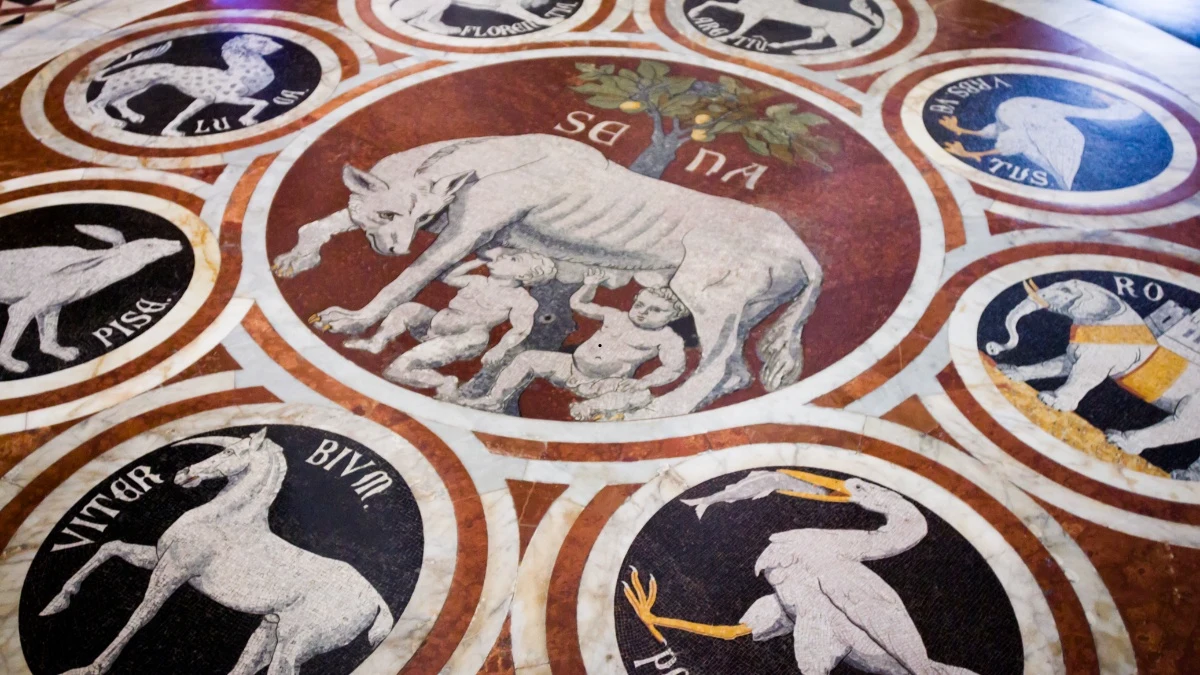Siena Cathedral (also known as Duomo di Siena) is one of Italy’s most remarkable architectural and artistic masterpieces.
This Cathedral attracts more than a million tourists annually with its breathtaking beauty, rich history, and artistic marvels.
Here are some fascinating facts that make the Siena Cathedral a must-visit destination:
There is a reason for the ‘black and white’ design

The Siena Cathedral is instantly recognizable by its striking black-and-white striped marble interior and exterior.
The alternating black-and-white stripes represent the colors of Siena’s coat of arms and are deeply rooted in the city’s history.
The black and white also signify humility (black) and purity (white), virtues highly valued in medieval Siena.
The Cathedral’s bell is very heavy
Siena Cathedral complex includes the Campanile (Bell Tower), which complements the Cathedral’s black-and-white striped design.
The bell on this Tower, installed in 1666, is known as the Campanone and weighs 6,764 kilograms (that’s 14,912 pounds).
It is dedicated to Our Lady of the Assumption.
Essential reading
How the she-wolf reached Siena Cathedral

In Siena Cathedral, the She-Wolf of Siena is depicted in two places – on the cathedral floor’s mosaic and on the façade.
In case you didn’t know, the She-Wolf, with twins Romulus and Remus, is the symbol of the foundation of Rome.
So how did Rome’s symbol reach Siena and eventually its Cathedral?
The myth is that twins Romulus and Remus founded Rome, but following some legitimation problems, the former killed the latter.
Remus had two sons – Aschio and Senio – who fled Rome to escape their uncle Romulus’s wrath and landed in Tuscany. Before they left Rome, they stole the Capitoline she-wolf from the Temple of Apollo.
According to the legend, Senio established the city of Siena upon reaching the Tuscan hills, while Aschio founded the nearby village of Asciano.
So now you know why the symbol of Rome is also in Siena Cathedral.
The Cathedral hosted Papal coronations
Siena, a powerful city-state in medieval and Renaissance Italy, boasted strong ties to the papacy.
As a result, the city’s magnificent Cathedral served as a stage for important papal events, including the coronation of Pope Pius III (in 1503), who was Archbishop of Siena until then.
His papal reign was brief, lasting only 26 days, but his connection to Siena left an enduring mark on the Cathedral.
The event is depicted in one of the frescoes in the Piccolomini Library, providing a visual record of this historic occasion.
It houses relics of the saint who inspired the Excalibur sword

Galgano Guidotti was an arrogant knight from Tuscany who turned into a Catholic saint after he had a vision.
When an angel urged him to repent his sins, Galgano protested, saying, “I can turn into a good man as much as I can split this rock with my sword.”
He drew his blade and thrust at the rock to prove his point, but the sword slid easily inside. This miracle was enough to convert him.
It has been almost a thousand years, and the sword remains.
The Siena Cathedral houses relics of this saint from Siena. If you want to see the sword, check out Abbey of San Galgano, which is just 35 km south of Siena.
recommended reading
The Cathedral is a result of Siena’s rivalry with Florence
Siena and Florence, two prominent cities in Tuscany, engaged in a long-standing rivalry for power and prestige during the medieval and Renaissance periods.

Siena, eager to assert its dominance and outshine its rival, embarked on a grand plan to expand its Cathedral, aiming to surpass the grandeur of Florence’s Santa Maria del Fiore.
The “New Cathedral” project, approved in 1339, was a massive expansion that would have more than doubled the size of the existing structure.
The Sienese wanted their Cathedral to be one of Europe’s largest and most impressive churches.
However, fate intervened in the form of the devastating Black Death in 1348. The plague ravaged Siena, decimating its population and crippling its economy, and as a result, the project got abandoned in 1355.
Today, the unfinished facade of the “New Cathedral,” is known as the “Facciatone.”
St. Catherine of Siena was a popular visitor
St. Catherine of Siena, a Dominican tertiary and mystic who lived in the 14th century, loved Siena Cathedral and often frequented it.
Tourists visiting Siena can still feel her presence, particularly in the Duomo.
Several artworks within the Cathedral and its associated museum depict scenes from St. Catherine’s life or pay homage to her sanctity.
During your visit, don’t miss the fresco in the Piccolomini Library, which depicts the Canonization of St. Catherine of Siena, an event in 1461.
The winner of a horse race gets rewarded at the Cathedral
Palio horse racing is a popular event in the city of Siena.
The race was first held in 1482 as a civic celebration. Since 1701, the intra-city horse race has been held semi-annually on July 2 and on August 16 since 1701, except during wartimes.
The race lasts about a minute and consists of three turns around the Piazza del Campo, the main city square.
A jockey and a horse from the 17 parts in which the city of Siena is divided participate, and the winner receives their banner at the Cathedral after the race.
Artists created the Cathedral’s floor over 600 years

Siena Cathedral’s floor was created over centuries, from the 14th to the 19th century, with contributions from around 40 different artists, primarily Sienese.
The 56 panels that make up the floor are crafted using a combination of graffito and marble mosaic inlay techniques.
These depict various scenes, including Sibyls, Old Testament scenes, allegories, and virtues.
Notable among them include the Wheel of Fortune, the She-Wolf of Siena with the Emblems of the Confederate Cities, and Emperor Sigismund Enthroned.
The floor is usually covered to protect it but is unveiled for a limited time each year, offering visitors a rare glimpse of its splendor.
recommended reading
The tomb that wasn’t to be
The Piccolomini Altar in the Cathedral was commissioned by Cardinal Francesco Todeschini Piccolomini, who intended it to be his tomb.
But soon enough, he was elected Pope Pius III and, after his death, was buried in the Vatican.
This altar has four sculptures of saints which Michelangelo created between 1501 and 1504. The statues are considered to be some of his earliest self-portraits.
The Crypt had frescos not seen by humans for 700 years

Beneath the grandeur of Siena Cathedral lies a hidden gem—the Crypt, a fascinating space shrouded in mystery.
Archeologists working on an evacuation project in 1999 rediscovered this underground treasure with stunning 13th-century frescoes and architectural marvels.
Interestingly, no human had seen these frescoes for more than 700 years.
During your visit, make sure to go down to the Crypt. You will need to purchase the OPA SI pass to gain access.
The Cathedral was built on an Ancient Site
Siena Cathedral was constructed on a former Roman temple and a church dedicated to Mary, dating back to the 9th century.
Evidence of this earlier structure can still be found beneath the Cathedral, adding to its historical depth.
These interesting facts offer insights into the history, art, and architecture of Siena Cathedral, preparing you for a more enriching and memorable visit.

